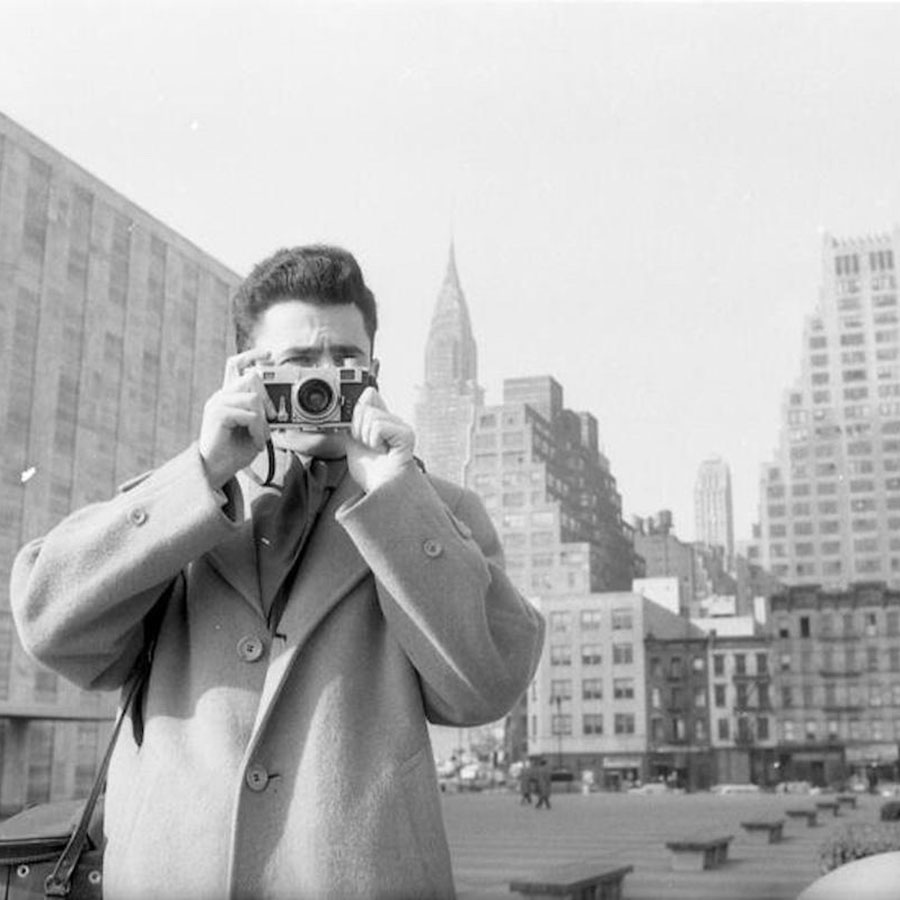Link About It: This Week’s Picks
Challenging the male gaze, an oral history of house music, an AR headset that locates hidden items and more

India’s Museum of Art and Photography Will Confront Biases
 Bengaluru, India opened a major cultural institution this month, the Museum of Art and Photography (MAP). In addition to the pre-modern and contemporary art and photography within its 60,000-piece collection, the five-story institution showcases textiles, posters and craft in an effort to eschew the industry’s elitism to create wider accessibility. “The entire differentiation between ‘high’ art and ‘low’ art, decorative arts and fine arts, is not an Indian concept,” says MAP’s founder Abhishek Poddar. As such, much of the museum is free to the public with fees waived weekly for any exhibitions that are priced. Their inaugural exhibit, Visible/Invisible, continues the museum’s mission to dismantle biases. Curated by MAP’s director Kamini Sawhney, the show confronts the male-dominated gaze within India’s art canon, presenting works that perpetuate depictions of women as desirable goddesses and opposing them with pieces that allow women to be mortal, vengeful and complicated. The three-year-long exhibit also includes transgender and non-binary artists. Learn more about the museum and its dedication to make space for marginalized communities at CNN.
Bengaluru, India opened a major cultural institution this month, the Museum of Art and Photography (MAP). In addition to the pre-modern and contemporary art and photography within its 60,000-piece collection, the five-story institution showcases textiles, posters and craft in an effort to eschew the industry’s elitism to create wider accessibility. “The entire differentiation between ‘high’ art and ‘low’ art, decorative arts and fine arts, is not an Indian concept,” says MAP’s founder Abhishek Poddar. As such, much of the museum is free to the public with fees waived weekly for any exhibitions that are priced. Their inaugural exhibit, Visible/Invisible, continues the museum’s mission to dismantle biases. Curated by MAP’s director Kamini Sawhney, the show confronts the male-dominated gaze within India’s art canon, presenting works that perpetuate depictions of women as desirable goddesses and opposing them with pieces that allow women to be mortal, vengeful and complicated. The three-year-long exhibit also includes transgender and non-binary artists. Learn more about the museum and its dedication to make space for marginalized communities at CNN.
Image courtesy of Museum of Art and Photography, Bangalore
De La Soul Discusses Their Legacy With Ebro
 Back in 2018, years before De La Soul’s music became available on streaming services and before Dave “Trugoy” Jolicoeur sadly passed away, the hip-hop trio spoke with Ebro (via Apple Music) about their catalogue and legacy. The group fought for control of their masters in order to share them digitally for many years; until now De La Soul had ostensibly been “erased from the digital era.” In this never-before-aired interview, Trugoy explains, “The biggest fear is just almost feeling like you’re being written out of history.” Maseo (aka Vincent Lamont Mason Jr) adds, “Being written out of history, let alone financially being taken advantage of.” That said, the conversation centers on their music: from learning from the greats to honing their expressive style, making up their stage names, crafting specific songs and looking back at their inimitable legacy. “We were just expressive kids not afraid to say, ‘This is me,'” Trugoy explains. Listen and watch on YouTube.
Back in 2018, years before De La Soul’s music became available on streaming services and before Dave “Trugoy” Jolicoeur sadly passed away, the hip-hop trio spoke with Ebro (via Apple Music) about their catalogue and legacy. The group fought for control of their masters in order to share them digitally for many years; until now De La Soul had ostensibly been “erased from the digital era.” In this never-before-aired interview, Trugoy explains, “The biggest fear is just almost feeling like you’re being written out of history.” Maseo (aka Vincent Lamont Mason Jr) adds, “Being written out of history, let alone financially being taken advantage of.” That said, the conversation centers on their music: from learning from the greats to honing their expressive style, making up their stage names, crafting specific songs and looking back at their inimitable legacy. “We were just expressive kids not afraid to say, ‘This is me,'” Trugoy explains. Listen and watch on YouTube.
Image courtesy of Apple Music
World’s Largest 3D-Printed Neighborhood
![]() 3D printing startup Icon collaborated with home-builders Lennar Corp and architecture firm Bjarke Ingels Group to create the Genesis Collection, 100 3D-printed homes in the Wolf Ranch suburb of Austin, Texas. These homes not only comprise the world’s largest neighborhood of its kind, but they are also built more efficiently, quickly, cheaply and sustainably than those made by traditional means, while being more resistant to climate change and offering unrestrained design opportunities. Icon uses a Vulcan printer, a 46.5-foot-wide robot that features a crossbar that moves alongside its foundation of two towers and a nozzle that moves from side to side along the bar. It is this nozzle that “prints” (like a piping bag) each layer of their proprietary concrete mixture, Lavacrete, which only requires 15 minutes to dry. Because Lavacrete is pliable and the robot can maneuver easily, the method allows curvilinear designs that are not typically offered at this price point. Learn more at Bloomberg.
3D printing startup Icon collaborated with home-builders Lennar Corp and architecture firm Bjarke Ingels Group to create the Genesis Collection, 100 3D-printed homes in the Wolf Ranch suburb of Austin, Texas. These homes not only comprise the world’s largest neighborhood of its kind, but they are also built more efficiently, quickly, cheaply and sustainably than those made by traditional means, while being more resistant to climate change and offering unrestrained design opportunities. Icon uses a Vulcan printer, a 46.5-foot-wide robot that features a crossbar that moves alongside its foundation of two towers and a nozzle that moves from side to side along the bar. It is this nozzle that “prints” (like a piping bag) each layer of their proprietary concrete mixture, Lavacrete, which only requires 15 minutes to dry. Because Lavacrete is pliable and the robot can maneuver easily, the method allows curvilinear designs that are not typically offered at this price point. Learn more at Bloomberg.
Image courtesy of Icon
An AR Headset That Locates Hidden Items
 X-AR is an augmented reality headset that combines computer vision and wireless perception to help wearers find hidden objects. Workers trying to locate specific products to fulfill e-commerce orders, for instance, could better locate objects tucked away in boxes or crates with the help of X-AR. Developed by researchers at MIT, the headset can see through cardboard, wooden dividers, plastic containers and other common materials by utilizing radio frequency signals and a lightweight antenna. The antennae picks up the measurements of the room through synthetic aperture radar. This builds a map of the environment which will search for objects with a radio frequency identification tag. When the right one is located, the headset then guides its wearer to the item, displayed as a transparent sphere on the set’s interface. Learn more about the technology at MIT News.
X-AR is an augmented reality headset that combines computer vision and wireless perception to help wearers find hidden objects. Workers trying to locate specific products to fulfill e-commerce orders, for instance, could better locate objects tucked away in boxes or crates with the help of X-AR. Developed by researchers at MIT, the headset can see through cardboard, wooden dividers, plastic containers and other common materials by utilizing radio frequency signals and a lightweight antenna. The antennae picks up the measurements of the room through synthetic aperture radar. This builds a map of the environment which will search for objects with a radio frequency identification tag. When the right one is located, the headset then guides its wearer to the item, displayed as a transparent sphere on the set’s interface. Learn more about the technology at MIT News.
Image courtesy of MIT
Using Sound Waves To 3D-Print Objects
 When an object is 3D printed, a computer processes an object’s design and sequentially “prints” each of its layers on top of one another. In a new form of 3D printing from the Max Planck Institute for Medical Research and Heidelberg University, the printer materializes objects by manipulating sound waves, a “touch-less” version of 3D printing. Just as sound can have an impact on the physical world (like when blaring noises cause objects to vibrate), this novel method manipulates acoustic fields to mold tiny matter (typically biological cells) into the desired shape. Researchers first programmed an algorithm to calculate forms through ultrasonic holograms by using GPU acceleration and Google’s TensorFlow. Then, the sonic printer fires ultrasound fields toward a lab dish housing the cells and shapes them into the new object, which occurs all at once rather than in layers. Whereas mechanical printing harms the health of cells, the sound waves move them gently and without contact, allowing them to stay sterile. This opens new opportunities for researchers to 3D print living tissue and viable organs. Learn more at Fast Company.
When an object is 3D printed, a computer processes an object’s design and sequentially “prints” each of its layers on top of one another. In a new form of 3D printing from the Max Planck Institute for Medical Research and Heidelberg University, the printer materializes objects by manipulating sound waves, a “touch-less” version of 3D printing. Just as sound can have an impact on the physical world (like when blaring noises cause objects to vibrate), this novel method manipulates acoustic fields to mold tiny matter (typically biological cells) into the desired shape. Researchers first programmed an algorithm to calculate forms through ultrasonic holograms by using GPU acceleration and Google’s TensorFlow. Then, the sonic printer fires ultrasound fields toward a lab dish housing the cells and shapes them into the new object, which occurs all at once rather than in layers. Whereas mechanical printing harms the health of cells, the sound waves move them gently and without contact, allowing them to stay sterile. This opens new opportunities for researchers to 3D print living tissue and viable organs. Learn more at Fast Company.
Image courtesy of Max Planck Institute
An Oral History of House Music
 After Beyoncé’s Grammys speech thanking the queer community for creating house music, NPR’s Throughline gathered quotes and anecdotes from various conversations to create a kind of oral history of the genre which began in Chicago in the late 1970s and early ’80s, thanks to Black and mostly gay DJs. The article includes significant moments for the genre: Frankie Knuckles moving to Chicago, the iconic Warehouse club, Jesse Saunders’ 1984 bop “On & On” (often considered the first house music track) and the rise of genres like acid house, trance and drum and bass in the 1990s. Stories and thoughts from Vince Lawrence, Lori Branch, Lady D and others illustrate the ways house is both a worldwide cultural phenomenon and a deeply personal one. “When you really listen to the range of what is in house,” Meida McNeal says, “musically, sonically, but also in the lyrics, you know, it is telling stories of love.” Read (and hear) more at NPR.
After Beyoncé’s Grammys speech thanking the queer community for creating house music, NPR’s Throughline gathered quotes and anecdotes from various conversations to create a kind of oral history of the genre which began in Chicago in the late 1970s and early ’80s, thanks to Black and mostly gay DJs. The article includes significant moments for the genre: Frankie Knuckles moving to Chicago, the iconic Warehouse club, Jesse Saunders’ 1984 bop “On & On” (often considered the first house music track) and the rise of genres like acid house, trance and drum and bass in the 1990s. Stories and thoughts from Vince Lawrence, Lori Branch, Lady D and others illustrate the ways house is both a worldwide cultural phenomenon and a deeply personal one. “When you really listen to the range of what is in house,” Meida McNeal says, “musically, sonically, but also in the lyrics, you know, it is telling stories of love.” Read (and hear) more at NPR.
Image courtesy of Jes Say Records
Motorola’s Rollable Phone
 Motorola has shared their rollable phone concept, an out-of-the-box and clever idea that features a touchscreen that rolls down to wrap around the bottom and back of the device. This allows the phone to essentially change in size, as when it wraps around the back the display is smaller and when it unwraps, the phone elongates vertically. The proof-of-concept can roll by manually double-pressing the side button, or it does so automatically when using certain apps. Watching a YouTube video and turning the phone horizontally, for instance, will trigger the phone to roll upward. In addition, the display at the back of the phone, when the screen is rolled down, enables different types of use. While taking photos with the back camera, it acts as a handy viewfinder. Learn more at CNET.
Motorola has shared their rollable phone concept, an out-of-the-box and clever idea that features a touchscreen that rolls down to wrap around the bottom and back of the device. This allows the phone to essentially change in size, as when it wraps around the back the display is smaller and when it unwraps, the phone elongates vertically. The proof-of-concept can roll by manually double-pressing the side button, or it does so automatically when using certain apps. Watching a YouTube video and turning the phone horizontally, for instance, will trigger the phone to roll upward. In addition, the display at the back of the phone, when the screen is rolled down, enables different types of use. While taking photos with the back camera, it acts as a handy viewfinder. Learn more at CNET.
Image courtesy of Andrew Lanxon/CNET
Super Cool World Ledger Nano X Designed by Nina Chanel Abney
 Renowned artist Nina Chanel Abney has teamed up with Ledger for a limited edition Nano X, the company’s pocket-sized cryptocurrency wallet, that’s been adorned with her cheerful, colorful design. It’s available through a raffle that’s open to Super Cool World NFT holders, and entering takes only a few steps. Rather than waiting for a draw, participants will know immediately if they have won. Find out more at Ledger.
Renowned artist Nina Chanel Abney has teamed up with Ledger for a limited edition Nano X, the company’s pocket-sized cryptocurrency wallet, that’s been adorned with her cheerful, colorful design. It’s available through a raffle that’s open to Super Cool World NFT holders, and entering takes only a few steps. Rather than waiting for a draw, participants will know immediately if they have won. Find out more at Ledger.
Image courtesy of Ledger
Link About It is our filtered look at the web, shared daily in Link and on social media, and rounded up every Saturday morning. Hero image: an untitled work by the artist JP Singhal from the late 20th century, courtesy of Museum of Art & Photography, Bangalore











